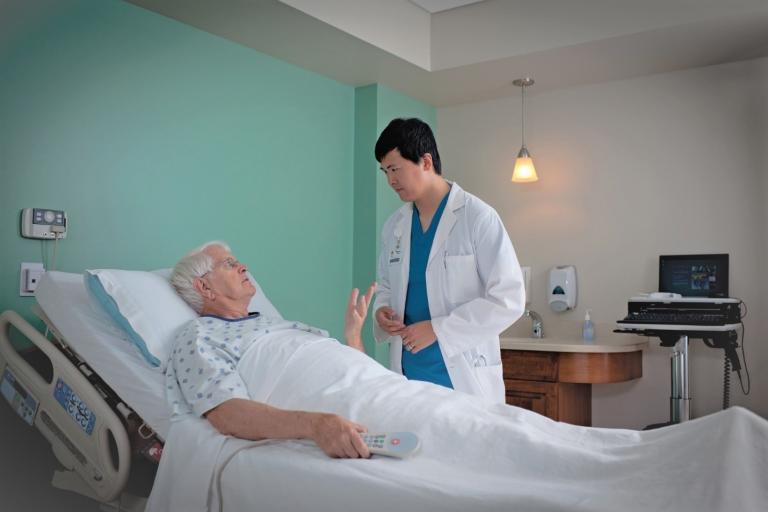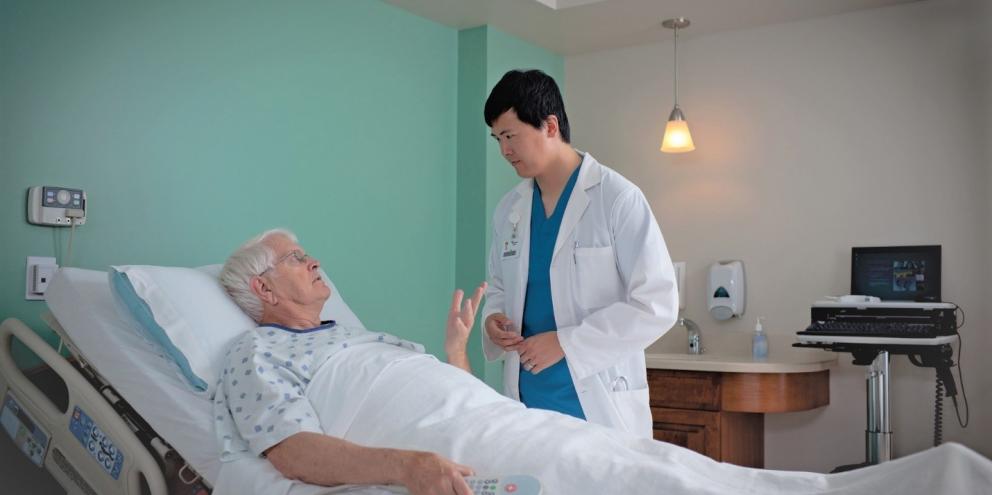
When a patient is in the operating room (OR) and in the post anesthesia care unit (PACU), their vital signs are monitored on a continuous or near continuous basis. This is because vital signs monitoring provides information to clinicians who may be able to act earlier to help prevent adverse events.
The connection between post-operative hypotension and myocardial injury is very strong in this period of recovery, as well as the hours and days after surgery making vital signs monitoring an important tool to support patients in the postoperative phase.[1]
Currently, once the patient leaves the PACU, postoperative vital signs are monitored via spot checking. The frequency of these spot checks may vary largely, ranging from every 4-6 hours up to every 8-12 hours.[2]
This means vital signs monitoring decreases from nearly continuous in the OR and PACU to as little as two to six times per day.
A 2022 survey explored the perceptions of over 1,100 anesthesiologists on vital signs monitoring frequency including the potential for continuous monitoring via wireless devices.
Survey Results from 1,158 Anesthesiologists
Continuous monitoring technology allows clinicians to view patient data in real time as well as track trends more closely. Traditional continuous monitoring included a lot of wires and sensors, tethering a patient to a bedside monitor.
Newer technology allows for wireless continuous monitoring, something that could be more appealing to patients and clinicians as well as improve patient safety.3
Over 1,100 anesthesiologists gave their input on continuous monitoring solutions - with a nearly 50/50 split between Western Europe and the United States.3 Over half of the respondents are board-certified anesthesiologists.
As far as current practices, 40% of anesthesiologists report using tethered continuous monitoring ‘occasionally’ while only 14% report using wireless continuous monitoring occasionally.3
While less than half of clinicians report using continuous monitoring occasionally, 90% of the anesthesiologists surveyed feel automatic or continuous monitoring of vital signs is something that should be available on surgical wards.3
86% prefer wireless sensors via wrist devices or bracelets over tethered monitoring.3
93% of respondents felt oxygen saturation was the most important vital signs to monitor, followed by heart rate (80%) and then blood pressure (71%).3
Respiratory rate was only recommended by half of those surveyed to be continuously monitoring. This is an interesting finding as respiratory rate is considered a highly sensitive marker of patient deterioration.3
Anesthesiologists feel continuous monitoring has the potential to support:
- Early detection of clinical deterioration
- Decrease in rapid response team (RRT) interventions
- Decrease in in-hospital mortality
These three main benefits have been illustrated by numerous studies showcasing benefit to the patient when there is continuous monitoring implementation.3
As far as criteria for continuous monitoring use, three out of four surveyed feel it should be reserved for clinical patients at high risk for postoperative deterioration – indicating the need for risk stratification tools.3
When it comes to alarm detection, 63% of anesthesiologists prefer the alarms to be seen and heard at the central station rather than in the patient room. Only 12% feel the patients should hear or see the alarm at all.3
Clinicians reported barriers to wireless continuous monitoring, namely cost and connectivity issues around the devices. 39% of those surveyed feel hospital costs would decrease while 34% feel costs would increase.3
Although there was a fairly even split on who feels costs would rise versus fall, 79% report the economic aspect to be the biggest barrier to implementation. And over half (58%) had concerns about nurse pushback being a barrier to wireless monitoring implementation.3
After the Patient Goes Home
In addition to the benefits of continuous monitoring in the hospital, certain patients stand to benefit using wearable devices once they go home, especially after surgery.
The 30 days after surgery is considered the period in which patients may become unstable and are more prone to complications and death, which may warrant close monitoring in certain patients during that period of time.[3] While 70% of post-surgical deaths occur prior to hospital discharge, that still leaves 30% of post-surgical deaths occurring after the patient initially goes home.[4]
When trying to determine how to best prevent post operative deaths, specifically after the patient goes home – monitoring various vital signs may be a potential solution.
Bleeding, myocardial injury, and sepsis are the main contributors to post-operative mortality.2 Postoperative hypotension is strongly associated with myocardial injury as well as renal injury and death making blood pressure monitoring something that could help clinicians indicate a patient who needs immediate attention.2
Like the other vital signs monitored, blood pressure is closely watched intraoperatively and immediately postoperative. However, as the patient becomes more lucid and seemingly stable, the frequency of monitoring tends to decline to around once every 4-8 hours, or as little as three times a day.[5]
We know adverse events, including cardiorespiratory events, tend to be preceded by a slow progression of worsening vital signs.[6] Knowing this, using continuous monitoring, including wireless, wearable devices that can be worn at home, could prove to be beneficial in identifying the start of any adverse events.[7]
With increasing technology allowing for wireless connectivity and less cumbersome devices, this introduces the option of monitoring patients closely even when they leave the hospital.
By creating algorithms to determine which patients would be best suited for continuous monitoring at home, as well as hemodynamic parameters to reduce the risk of alarm fatigue – continuous monitoring in the home setting could be a useful tool in certain postoperative patients.
Patients are diligently monitored in the OR and ICU and although they are considered stable enough to be discharged, research shows some are still at risk.8
While more research is needed to determine the full benefit as well as determining criteria on selecting patients who could benefit from home monitoring, it is something that may help improve patient outcomes postoperatively.
Being able to remotely monitor these patients when they return home has the potential to bring patients peace of mind as well as support clinicians in their post-operative care.
Summary
- Postoperative vital signs monitoring decreases rapidly as the time after surgery increases
- Postoperative changes in vital signs, specifically blood pressure, has a strong connection to postoperative mortality
- Over 1,100 anesthesiologists surveyed shared opinions on wireless continuous monitoring with many feeling it should be made available for certain patients on the ward
- Anesthesiologists feel continuous monitoring could help reduce adverse events and improve patient outcomes in the postoperative period once the patient leaves the PACU
- Cost is the largest barrier to implementation reported by clinicians
- With technology improving the ability to provide untethered monitoring, clinicians should consider the potential benefit of monitoring certain patients once they leave the hospital
References
[1] Olsen, F & Khanna, A. (2022). Monitoring postoperative hypotension – a futuristic look at patient safety. ICU Management. 22(1). 34-38.
[2] Khanna, A et al. (2019). Association Between Mean Arterial Pressure and Acute Kidney Injury and a Composite of Myocardial Injury and Mortality in Postoperative Critically Ill Patients: A Retrospective Cohort Analysis. Critical Care Medicine. 47(7): 910-917.
[3] Michard, F et al. (2022). Wireless wearables for postoperative surveillance on surgical wards: a survey of 1158 anaesthesiologists in Western Europe and the USA. BJA Open. 1 (C). 1000002.
[4] Bartels K et al. (2013) Perioperative organ injury. Anesthesiology. 119(6):1474–1489.
[5] De Vries EN et al. (2008) The incidence and nature of in-hospital adverse events: a systematic review. BMJ Quality & Safety. 17(3):216–223.
[6] Khanna AK, Hoppe P, Saugel B (2019) Automated continuous noninvasive ward monitoring: future directions and challenges. Critical Care, 23(1):194.
[7] Andersen LW et al. (2016) The prevalence and significance of abnormal vital signs prior to in-hospital cardiac arrest. Resuscitation. 98:112–117.








